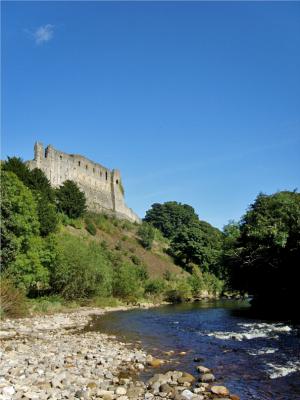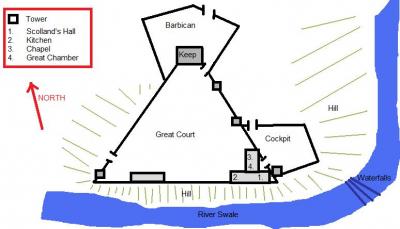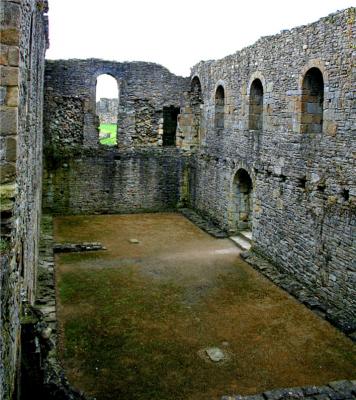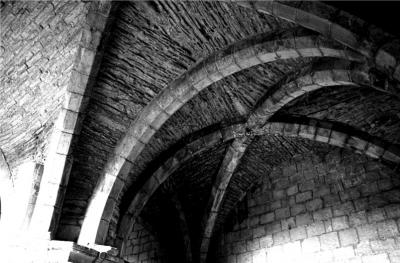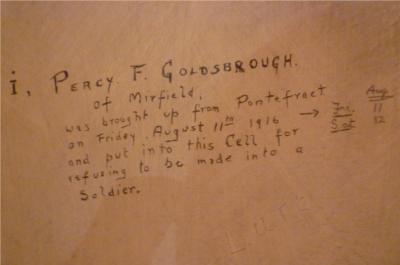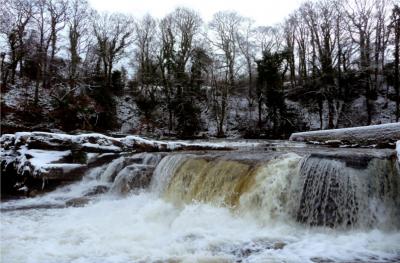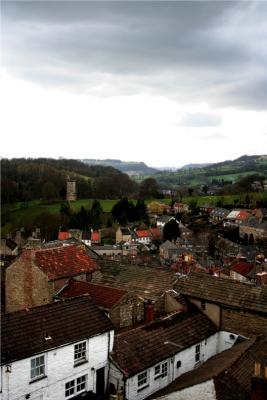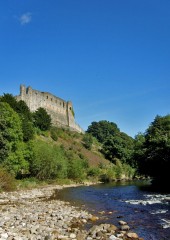Introduction
Richmond castle has had a long and varied history, beginning with the Norman invasion in 1066. Located on the eastern edge of the Yorkshire Dales, the castle stands as the centrepeice of the market town that has grown up around it, with a population of nearly 10,000.
The Norman Invasion
After William the Conquerer had taken control of Britain between 1066 and 1069, he gave away large areas of land to some of his most trusted followers. One of these was Alan Rufus, William's nephew, who was given a large estate - the land on which Richmond castle now stands - with the aim of suppressing resistance in Yorkshire and acting as a defence against the Scots and Danes. This estate later became known as the Honour of Richmond, with the name coming from the town of 'Richemonte' in Normandy (anon (a), nd).
Alan Rufus was a key figure in the Harrying of the North, and also constructed a castle at nearby Middleham in Wensleydale. Upon his death at the age of 53, his wealth accounted for 7% of the total national income, which in modern day terms is the equivalent of ?83 billion, therefore making him the wealthiest person in Britain's history (Beresford & Rubinstein 2007, cited Narain 2007, n/a).
The area of land was carefully chosen so as to make the most of the natural defenses available. It sits high above the River Swale, with a 20m drop to the water below (Fig.1). The river is the second fastest in the country and curves around two sides of the triangular bailey, with more steep slopes adding to the natural defensive elements.
In addition to the obvious defensive benefits of the River Swale there were few people living further up Swaledale so it was remarkably unpolluted, providing a constant supply of fresh, clean water. Finally, the site of the castle provides extensive views in all directions, but particularly to the south - where, on a clear day, York can be seen - and east towards the North York Moors. This would obviously be useful for spotting any potential attackers from the more populated Vale of York, a long way off.
The Castle
Work was started on the castle in 1071 and it has stood for almost a thousand years, making it one of the oldest stone castles in the country, along with Durham and Colchester (anon (a), nd). Very little of what can now be seen is actually the original structure, as a lot has been added since, including the Keep itself which was only built in the late 12th century. The archway underneath the Keep, and certain areas of masonry along the east and west walls still remain, but even these features are well disguised amongst more recent additions. The Keep was built by Conan 'the little', who also constructed the barbican, replaced the wooden palisade on the southern flank with a stone wall and fortified the cockpit (Fig. 2). These changes were made in response to increased insecurity and turmoil at the time and were completed by Henry II.
In the south eastern corner of the castle are a number of important buildings where the Earl would have spent a lot of his time. These include Scolland's hall (Fig. 3), a two-storey building with a great hall on the first floor which would have been used for banquets. Other sections were added later, such as the kitchen in the 12th century and the Chapel and Great Chamber in the 14th. At this time, a large window was installed at the eastern end of Scolland's Hall, to provide better light to the area where the Earl would have sat.
The Keep, as previously mentioned, was a 12th century addition to the older gatehouse with walls 11ft thick towering 100ft above the town. It consists of three floors; the basement, a lobby and some chambers on the first floor, and a great hall on the second. There is evidence to suggest that there could have been another floor above this as a few beam holes, possibly for beams, remain along one wall. The gabled roof of this top floor would still have been well below the battlements, which could be accessed through stairways within the walls themselves.
The original gatehouse is still mainly intact, although a large number of alterations have subsequently been made. Upon building the Keep on top, the gate was actually blocked up, with the only access to the basement then being through a spiral staircase from the first floor. This was because access to the Keep was via the first floor anyway, allowing for greater protection of the water supply from the well in the basement (Vasey & Walmsley 2008, n/a). The roof of the basement, unlike others, was built of stone in order to provide protection from fire, help support the rest of the keep and to help keep food cool. Around 1330, a ribbed vaulted roof, which can be seen in Fig. 4, was also added to the basement - an interesting sight for today's tourists who can once more gain entrance through the unblocked basement arch.
The castle has had many uses over the last millenium. Before falling into disrepair it held numerous important prisoners and changed ownership on a regular basis. In 1174, King William the Lion of Scotland was imprisoned there, as was David II in 1346 (anon (a), nd). Henry VII was another notable figure to have been Earl of Richmond and regularly visited the castle after his victory at the Battle of Bosworth Field. He then passed this honour on to his illegitimate grandson, Henry Fitzroy, before Henry VIII regained the title, which has belonged to the crown ever since (Peter Jackson, pers comm. April 2010).
War
In more recent times, the castle has been used as a barracks and again as a prison. In 1855 it became the base for the North Yorkshire Militia and a barracks block was built in the great court, whilst the keep was used to store clothing and arms. During the First World War it was used as a base for the Non Combatant Corps (NCC), a section of the armed forces for those who refused to fight on conscientious grounds. It also served as a prison for absolutist conscientious objectors who refused to help the war effort in any way, a group of whom famously became known as the 'Richmond 16'. They were among the first people to defy conscription on moral grounds, causing serious debate in parliament and the eventual reform of the prison service. This was as a result of many having mental breakdowns or even dying whilst serving their time in prison, although they were fortunate in the first place to avoid death, the common punishment for refusing to fight on the front line. Figure 5 is a good illustration of some of the graffiti these prisoners left behind on the cell walls consisting of pictures, poetry and general information about themselves.
World War Two saw the castle again used to house military prisoners, whilst the Keep itself was used to spot enemy aircraft.
The Town
At the time the castle was built, three suburbs sprang up to house the workers - Frenchgate, Bargate and Newbiggin - all three of which survive to this day. Over the following 200 years the town increased in size, and more people began living just outside the castle walls to the north. In 1311 more stone walls were built as an outer bailey to protect this area of land from the Scots and these form the shape of what is now the biggest horseshoe market-place in the country (Peter Jackson, pers comm. April 2010). The original postern gateways still exist between some Georgian buildings that form the outer edge of this marketplace. Two bigger gateways - Frenchgate and Finkle street - were well fortified as they were wider to allow for greater traffic in and out of the market place making them vulnerable to attack. Even the name Finkle street indicates this as it means 'angled street' and reflects the slight bend in the street. This made it more awkward for enemies to see what was up ahead and gave the defending swordsmen more room to fight.
In Georgian times, the town expanded rapidly due to it's convenient location between the mining and knitting industries of the Dales and the ports of Newcastle and Hull. This brought a number of wealthy merchants to Richmond who greatly influenced the future of the town. Large portions of the outer walls were knocked down to improve access to the market place and new structures with their distinctive Georgian architecture were built in their place. Other Georgian buildings in Richmond include the rebuilt Grammer School, which was originally opened by Queen Elizabeth I and attended by Lewis Carroll and the Bishop Blaize - the centre of the knitting industry, and The King's Head hotel. This was built by the Bathhurst family in 1718 who had made their money from lead mining.
It was at this time that tourism became an important factor and the continuing popularity of the King's Head hotel is testament to this. With the newfound local and national wealth from trading abroad tourism became more popular and the historic features of Richmond, situated so close to one of the most beautiful areas in the country, made it a very desirable destination. One notable visitor to Richmond was the famous landscape painter William Turner (anon. 2004, n/a), drawn by the romantic ruins of the castle and the river with it's beautiful waterfalls (Fig. 6). His paintings of Richmond only served to further enhance it's popularity as a tourist destination over the following centuries.
The town now relies almost completely on tourism, still benefitting from it's proximity to the ever popular Yorkshire Dales National Park and more immediately Swaledale (Fig. 7). The famous fell walker, Alfred Wainwright, chose Richmond as the only major town on his popular coast to coast walk, resulting in many thousands of tourists from all over the world passing through every year.
Conclusion
Throughout its life, Richmond Castle has been used for numerous purposes by many different people and has slowly evolved over time. Interestingly, it has never been involved in any major battles, although there is some evidence to suggest that minor skirmishes with occasional Scottish raiding parties did occur (anon. (b), nd). Thanks to this unusually peaceful, yet still varied, history it is fortunately still standing proudly above the Richmond skyline. It is now owned by English Heritage and as a major tourist attraction in its own right will continue to fascinate for generations to come.
All the photographs featured in this article belong to Mat Robinson. To see more of Mat's photography visit: www.redbubble.com/ or http://www.richmond.org/arts/mat-robinson/index.html.
References
- Anon. (2004) 'Yorkshire's castles: Richmond Castle', http://www.bbc.co.uk/dna/h2g2/A2350126. Page consulted 26th April 2010
- Anon (a). nd. 'Guide to Richmond: Richmond Castle', http://www.richmond.org/guide/castle/castle.html. Page consulted 25th April 2010
- Anon (b). nd. 'Richmond Castle: A Brief History and Description of Richmond Castle, Yorkshire, England' http://www.richmondancestry.org/richmond_castle.shtml. Page consulted 26th April 2010
- Beresford, P. and Rubinstein, W. (2007) The Richest of the Rich: The Wealthiest 250 People in Britain Since 1066. Petersfield: Harriman House Publishing.
- Narain, J. (2007) '1066 Invader was Britain's wealthiest man in history', . Page consulted 25th April 2010
- Vasey, M. and Walmsley, D. (2008) Richmond Castle Teacher's Kit. English Heritage



